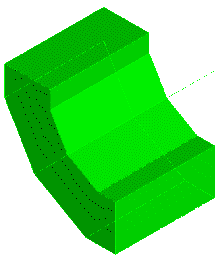Guidelines for Creating a Revolution
Once you have OK’d the settings in the Revolve Planar Profile dialog, the Selection Menu will allow to you to choose the curves that comprise the set.
When selecting the planar curve profile(s), it will be important to know the following:
-
All curves must be lines, arcs, conics, or splines.
-
The order of selection is unimportant.
-
The entire set must represent a closed curve if the Midplane option is used.
-
The entire set must lie on a plane.
-
Multiple closed co-planar profiles may be chosen in one operation.
-
When choosing multiple profiles keep in mind that:
-
Overlapping and intersecting profiles are automatically trimmed to one another.
-
Profiles that are intended to be holes within a larger outer profile are automatically detected and cut away.
-
There are several rules that will govern the resulting color of a solid when multiple profiles are used for revolve operations:
-
If the Get attributes from profile geometry setting is enabled under Tools>Options>Solids >Profile Functions, the attributes of the profile being extruded, swept, etc, will be retained in the result.
-
If the profiles are of different colors, the first one selected will determine the color of the resulting solid.
-
If the profiles are of different colors and ALLDSP>ALL or By TYPE is used to select the profile geometry type, the color of the first one encountered in the part file database will be used. This means that the database direction will also influence the color of the resulting solid.
-
You will be prompted to select a revolve direction vector. Then you will be prompted to define the axis of rotation. The axis must lie on the plane the profile is on. You can use Two Points, Line, Vector, Tangent, Perpendicular to Plane, or Key In to define the axis.

Above > A rectangle revolved about the line with a 90-degree angle and 3 steps. The revolution is segmented in 30-degree increments.